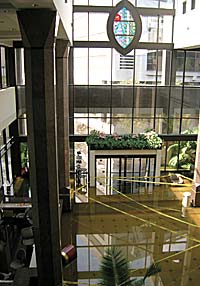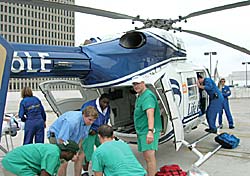Five days at sea — in the city of New Orleans
The following are excerpts from a first-person diary account of coping and survival by Duane Belongie, MD, an orthopedic resident at Tulane University Medical Center.
“… We weathered the storm and its aftermath for five days at Tulane, Charity and University hospitals … If we were doomed to be flooded in, I didn’t want to be stranded at Charity Hospital. So I went back to the boarded-up house on the west bank and loaded my old 17-ft canoe into the truck. …
|
“At about 1 am, the windows to the junior call room exploded into the darkness, and over the next few hours, we could hear other windows doing the same all the way down the hallway. Water started to creep in from under locked doors, soaking the hallway quickly. ... One of the staff described having walked into the anesthesia office and seeing the window A/C unit torn out of the window, spinning apparently weightless in place for several seconds, like a prop from the movie “Poltergeist,” then plummeting to earth into the darkness. The winds continued to howl as the sun came up. As I surveyed the skyline, a large segment from the roof of a tall building, a piece about 25 feet across, seemingly levitated and hovered weightlessly over the street, till it too realized its tenuous hold on reality and plummeted toward the street below, crushing another roof under its weight and splintering debris out into the surrounding street. These scenes were repeated in slight variations throughout the city. … The canoe was definitely going to get some use. …
“… It was a strange perspective from canoe level in the streets. By now many of the cars were submerged, most of them with windows broken out by the storm or by the first wave of looters. …
“When we arrived at UH, a neonatal intensivist met us at the entrance and asked us how feasible it would be to transport two ventilator dependent preemies to that fire truck, which had been unable to get close enough. We looked at each other in relative disbelief, and I said that I didn’t think we could bag them both at the same time and safely get them to the rescue truck. Allen suggested doing one at a time. So they asked us if we were EMS or emergency medicine residents. We replied that we were orthopedics residents. The silence was palpable for several seconds, as there is probably no service in all of medicine less likely to offer to bag a two-pound preemie under any conditions. However, there is also no other service more likely to come up with something as useful as a canoe when one was needed, so they showed us how to deliver short, quick breaths to the infant, and off we went with preemie number one. We got considerably less abuse from the onlookers who were observant enough to realize what we were doing. The first package was delivered to the incredulous EMS rescue team. After ascertaining that the neonate had arrived pink and none the worse for wear, we returned for round 2, considerably more confident that we could pull it off. The second trip was flawless as well, and shortly the diminutive pair was whisked away to the children’s hospital.
“We made a few more runs back and forth transporting diesel fuel for the generators, then headed over to the Tulane hospital with some critical ICU blood samples. They were unable to be run at Charity, so we carried them to the lab at Tulane.
“Initially, we were told that all Charity patients would be transferred to University, and Charity Hospital would close, most likely forever. … This was before the water really started to rise and there was still the possibility of accepting new patients with orthopedic trauma. With this plan we only got as far as to gather all our belongings and lug them down 14 flights of stairs. Within minutes we learned that UH was worse off than CH, with its roof supposedly blown off and severe flooding everywhere. … At this point, water had completely saturated the basement of Charity (which incidentally is where both the cafeteria and morgue were located) and was seeping into the first floor. Running water was running no longer, and toilets were not even flushing. ... Five-gallon buckets and plastic bags were handed out to everyone for portable latrines. Things were getting ripe to say the least. …
“… The patients were getting a bit restless, but they were hanging in there. With the staggering heat and humidity, there wasn’t a patient with a stitch of clothing on in the entire ward. Enough said … apparently the stifling heat was contributing to postop infections in almost every Tulane surgical patient.
Courtesy of Duane Belongie |
“The details began to blur as the disaster unfolded. We had no television or worthwhile radio stations to inform us of the outside situation. News from the outside was coming in less frequently, and did not jibe with what we knew was actually happening.
“… Nineteen [new] patients materialized on Thursday morning and were brought up to the staging area where about 300 family members, staff and employees started to line up for evacuation at 7 am. Most of the patients appeared stable, not requiring mechanical ventilation or pressors. In addition to the Tulane patients, arrangements had been made to bring over 20 of the critical Charity patients who were to be evacuated by two Blackhawk helicopters ... Their arrival was supposedly timed to coincide with the arrival of the Blackhawks, as many of them were ventilator dependant and required manual bag ventilation while awaiting transfer to skilled transport choppers. For eight hours, the Blackhawks never came. Two of the ventilator dependent patients died on the ramp awaiting transport. Nobody knew where the choppers had gone.
“ … There was literally no line of communication other than smoke signals and walkie-talkies available up to that time… Hope was dwindling for an escape before nightfall.
[But] Finally … the Blackhawks were on the way. …
“[After being flown from Tulane Medical Center to the municipal airport,] we waited for an armed vehicle to escort us off the tarmac. We were delayed momentarily for the unloading of a large military transport plane, reportedly filled with medical staff to tend to the staggering 4000 estimated patients from all of the local hospitals, now housed in the airport. Apparently there were only a handful of medical personnel available prior to their arrival, and things were awful inside, with insufficient supplies or staff, and people dying. … I guess I was naïve to think that simply getting those patients off the roof at Tulane was somehow going to make everything better. I can’t speak for everyone else, but I was so fixated on getting those patients transferred out, that I never considered even where they were going and what they were in for. I also realized that what we endured was but a tiny ripple within Katrina’s wake. That is partly what made this whole tragic event such a disaster. The scope was so huge that the city and the nation were stunned, delaying the initiation of meaningful relief efforts. So many others, from the Superdome to the Gulf Port, were so profoundly affected by this mess that it will take an eternity to return a sense of normalcy, and things will truly never be the same. It is extremely sad that in 21st century America, these circumstances came to pass.


